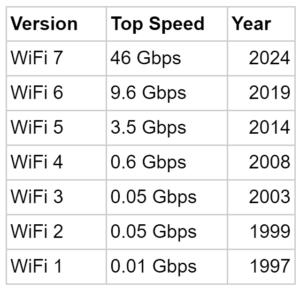What are the potential possibilities of Wi-Fi 7?
- Multi-Gigabit Speeds: Wi-Fi 7 could potentially offer even higher data rates and throughput compared to previous Wi-Fi standards, enabling multi-gigabit wireless speeds. This would support bandwidth-intensive applications, such as 8K video streaming, virtual reality (VR), augmented reality (AR), and immersive gaming experiences.
- Increased Capacity and Device Density: Wi-Fi 7 might address the growing demand for handling a massive number of devices in dense environments. It could potentially improve spectral efficiency and provide better ways to manage and allocate wireless resources, allowing for more simultaneous connections and improved performance in crowded areas like stadiums, conference centers, and urban deployments.
- Extended Range and Coverage: Wi-Fi 7 could potentially enhance the range and coverage area of wireless networks, allowing for better connectivity in larger physical spaces and improving signal strength and quality throughout a building or outdoor environment.
- Lower Latency and Improved Quality of Service: Wi-Fi 7 may focus on reducing latency further to improve real-time application responsiveness. This could be crucial for applications that require near-instantaneous communication, such as online gaming, video conferencing, and voice over IP (VoIP) services.
- Enhanced Security and Privacy: Wi-Fi 7 might introduce improved security mechanisms and protocols to address emerging threats and vulnerabilities. It could offer stronger encryption, authentication methods, and privacy features to ensure the security and integrity of wireless communications.
- Energy Efficiency and IoT Support: Wi-Fi 7 could potentially optimize power consumption and introduce energy-saving mechanisms to extend battery life for connected devices, particularly for Internet of Things (IoT) devices and battery-powered devices. It might also provide better support for IoT deployments, enabling seamless connectivity and management of a large number of IoT devices.
- Seamless Roaming and Network Integration: Wi-Fi 7 might improve seamless roaming capabilities, allowing devices to transition between different Wi-Fi networks or access points without interruptions or manual reconnections. It could also facilitate better integration with other wireless technologies like cellular networks, enabling seamless handover between different network types.
It’s important to note that these possibilities are speculative and based on anticipated advancements in wireless technology. The final capabilities and features of Wi-Fi 7 will be determined when the official standard is released and implemented.
Now, we have to know the specifications of Wi-Fi 7
- Increased Data Rates: Wi-Fi 7 is expected to deliver even higher data rates compared to Wi-Fi 6, potentially reaching multi-gigabit speeds to accommodate the growing demand for bandwidth-intensive applications.
- Improved Spectrum Efficiency: The standard may introduce advanced techniques to enhance spectral efficiency and make more efficient use of available frequency bands, enabling higher capacity and better performance in crowded environments.
- Enhanced MIMO and Beamforming: Multiple-Input Multiple-Output (MIMO) technology is likely to be further advanced in Wi-Fi 7, allowing for increased spatial streams and improved beamforming capabilities. This would enhance signal strength, coverage, and overall network performance.
- Lower Latency: Wi-Fi 7 may aim to reduce latency even further, providing more responsive connectivity for real-time applications and enhancing the user experience for activities like gaming, video streaming, and voice calls.
- Advanced Security: The standard is expected to introduce improved security mechanisms to address emerging threats and vulnerabilities. This might include stronger encryption protocols, enhanced authentication methods, and better privacy features.
- IoT Optimization: Wi-Fi 7 is likely to provide enhanced support for Internet of Things (IoT) devices, addressing the unique connectivity and power requirements of IoT deployments. This may involve energy-saving features, better scalability, and improved management capabilities for a large number of connected IoT devices.
Speed of the WiFi 7 according with its versions





